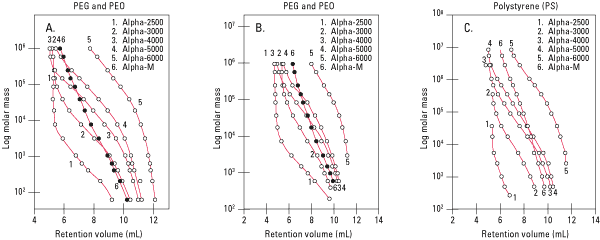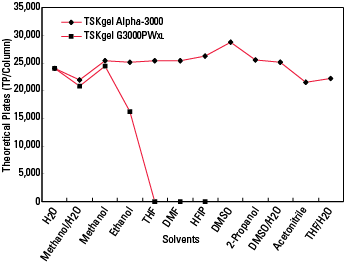TSKgel Alpha Columns for the Analysis of Polar Organic-Soluble Polymers
The main application area for TSKgel Alpha columns is the analysis of polymers that are soluble in polar organic solvents. Examples of applications include cellulose derivatives, polyimide, and sodium dodecylsulfate (all in DMF with 10 mmol/L LiBr), cleansing gel in methanol, and degree of saponification of polyvinylalcohol in HFIP. These columns contain highly crosslinked hydroxylated polymethacrylate particles which minimize swelling in polar organic solvents.
Mixed bed TSKgel Alpha Column
The mixed bed column, TSKgel Alpha-M, has an extended linear calibration range, and is suitable for samples with a broad molar mass (MM) distribution as well as samples with unknown molecular mass.
Calibration curves of all Alpha columns
|

|
Column: TSKgel Alpha columns, 7.8 mm ID × 30 cm
Mobile phase: A. H2O
B. MeOH containing 10 mmol/L LiBr
C. DMF containing 10 mmol/L LiBr
Flow rate: 1.0 mL/min
Detection: RI
Temperature: A. 25 °C B. 25 °C C. 40 °C
Samples: A, B: polyethylene glycol (PEG) and polyethylene oxide (PEO) standards
C. polystyrene (PS) standards
|
|
Unlike TSKgel PW-type columns, which are stable at most to a 50% organic mixed with water, TSKgel Alpha columns offer excellent stability in 100% aqueous to 100% organic solvents. Suitable organic solvents are shown in the figure below.
|
 |
Conditions of solvent change
Flow rate: 1.0 mL/min
Temperature: 25°C
Time for purge: 8 h
Conditions for TP measurement
Flow rate: 1.0 mL/min
Detection: RI
Temperature: 25°C
Sample: ethylene glycol
|